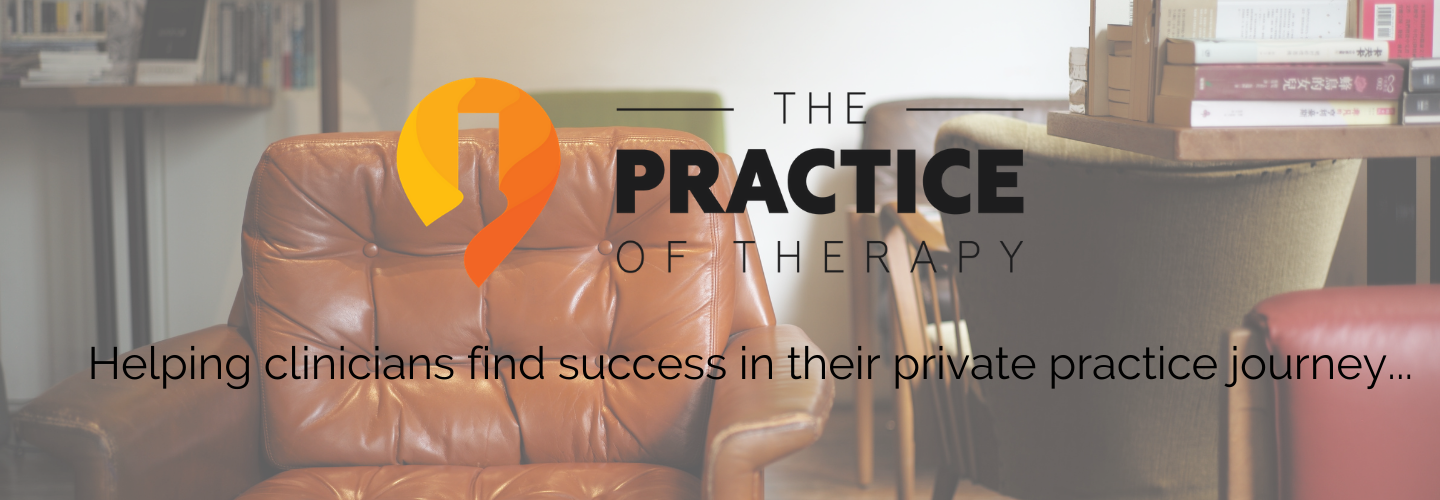![]() One of the most important things to remember about being in private practice as a counselor or therapist, is the fact that you are running a business. The dilemma that I hear most from people going into private practice, is that they feel like they lack some basic business and financial knowledge they need. The truth is, I was exactly the same! It is very rare that someone in graduate school would have gotten any training or coursework in running a private practice. This is especially true for the financial side of things in private practice.
One of the most important things to remember about being in private practice as a counselor or therapist, is the fact that you are running a business. The dilemma that I hear most from people going into private practice, is that they feel like they lack some basic business and financial knowledge they need. The truth is, I was exactly the same! It is very rare that someone in graduate school would have gotten any training or coursework in running a private practice. This is especially true for the financial side of things in private practice.
Accounting for the Non-Accountant
Unless a person happens to be an accountant or has had some coursework in accounting, most people have rudimentary knowledge at best. For me, when I went into private practice, I knew how to balance my checkbook, but that was about it! Accounting and bookkeeping were never my forte. I had to learn all this later on and it was confusing! But if you break it down into simpler terms it a little easier to understand.
In this blog post I’ll walk you through some basics of accounting and bookkeeping that you need to know in order to run the business side of private practice.
In the previous blog post I did, I talked about the importance of knowing how to make the transition from being employed to being self-employed. We talked about some of the different ways to structure the business in terms of it being a sole proprietorship vs. a LLC or other business entity. This is an important concept when it comes to the financial side of private practice. Regardless of which structure you use, you should treat the practice as something separate from yourself. It should be its own entity or “thing”.
As you set up the financial side of your practice, do consult with a financial expert in your state or locale. Accounting practices and laws do vary.
Keeping Your Practice Finances Separate
The first thing, which might seem obvious, is that should keep your practice finances separate from your personal finances. In other words, have separate bank accounts, tracking, etc. Then you pay yourself just like getting a paycheck from a job (more on this later.) One of the best ways to do this is to simply have a separate checking account that you use to manage the money for your practice.
Secondly, is to have a system in place to track and record your finances. It could be something as simple as a paper based notebook or spreadsheet. A better idea though is to invest in some sort of accounting or bookkeeping application/software. That way you can track your income and expenses for both business and tax purposes. There are several of these out there. Quickbooks and Freshbooks are two that I can recommend. They give you the tools you need to track both the income and expense side of things along with producing the reports you need to get a snapshot of your finances and growth.
So let’s break all this down some more. There are a few accounting principles and concepts that you need to know first in order to do this.
Assets
When you set up your practice, everything of value that is part of that business is considered an asset. There are both tangible and intangible assets. The cash you start the practice with, furniture you buy, money you borrow (credit cards, loans, etc.), computers, phones, or any office supplies, all become tangible assets of your practice. The money you have in your business checking account is a tangible asset.
Intangible assets are things like money owed to you and even the values of potential appointments on your calendar that you have not had yet. When you add the value of all those together (tangible and intangible assets) the number you get is what is your total assets (keep this in mind). And from a business accounting standpoint, that big lump sum number is what you can potentially pay yourself from.
Owner’s Draw
When a business owner pays themselves, it is referred to as an “owner’s draw”. So whatever you pay yourself from the business reduces the total of the practice assets by that much.
Equity and Liabilities
Equity and liabilities are terms that are used to describe how all of your assets interact with each other. Liabilities are simply money that you owe to someone else; bills or payments you need to make. Things like rent, electric or phone bills are liabilities. Also things like credit card balances or loans for equipment make up your liabilities.
Equity is simply your total assets minus your liabilities. Your equity is very much tied to your income. As you make money and get paid for your services, your equity increases. Equity decreases as your liabilities increase. And hopefully your equity stays on the plus side!
Income and Expenses
The other accounting terms you are probably most aware of are “income and expenses”. Any business strives to make a profit. Profit, of course, is when your income is greater than your expenses. “Gross income” is all the money you take in during a period of time. Net income is your gross profit minus your expenses.
Expenses are anything you need to pay out in order to run your practice. Expenses are somewhat tied to liabilities, but not always. Remember, a liability is something owed. Some expenses are simply money you pay out when needed. For example, office supplies you buy when you need them are an expense but not a liability, unless you used a credit card to buy them.
Taxes
So when it comes to your income taxes, the main thing you need to be concerned with is tracking your income and expenses. The IRS only requires that you pay taxes on your net income. So you can deduct legitimate business expenses on your income taxes. That is why it is so important to track and keep a record of those things for your taxes.
Most anything you buy for your practice can be used as a tax deduction. It’s important to keep this in mind as you move through the year. Save your receipts and write everything down. You can even deduct the mileage you use for business purposes. So if you travel somewhere for continuing education, you can deduct that as well.
One note about taxes: be sure that you are paying quarterly self-employment taxes on your net income for your practice! Otherwise you could get “dinged” at the end of the year with a big tax bill and/or penalties for not paying enough. (Talk to an accountant about this!).
Reports
One advantage to using an application like FreshBooks or Quickbooks is that you can create reports that will instantly give you a snapshot of your practice finances. They also give you a way to track your expenses in a way that is “IRS friendly”. At the end of the year all you have to do is print a few reports to get everything you need to file your income taxes.
Balance Sheet
If you are using an application like Freshbooks or Quickbooks, you can get a balance sheet report. What this will do is give you a snapshot of your assets, liabilities and equity. These numbers will vary from day-to-day depending on how much money you take in and pay out. Also it will vary according to how much debt you owe. What that does is let you see is if you are doing well or not over time. Ideally you want your equity to be greater than your liabilities.
Profit and Loss Statement
Another report that is a good to look at often is the profit and loss statement. This will give you a good snapshot of your practice and if you are actually making money or not. It will show you where your money is coming in from (income). It will also show you where you are spending your money for expenses. And best of all, it will show you how much profit your practice has made for any particular period of time.
Profit Margins
Your profit and loss statement can be used to let you know your “profit margins”, which is the percentage of profit made from each session.
For example, if your monthly expenses for keeping your practice going is $1000 (rent, advertising, phones, liability insurance, self-employment taxes, etc.). Your profit margin will depend upon how much you charge per session and how many sessions you have. So if you charged $100 per session you would need to have 10 sessions to “break even”. Anything over 10 sessions is profit.
If your average number of sessions a month is 60 sessions:
60 x $100 = $6000.
Subtract your expenses: $6000 – $1000= $5000.
$5000/$6000 = 0.83 (83% profit margin)
That means it costs you $17 per session to cover your expenses
Obviously, the more sessions you have the greater profit margin you will have and vis versa. Fewer sessions means a lower profit margin; it would cost you more per session to stay in business.
Finally, it is important to understand how all these things work together. This will allow you to know how much money you are making and predict future growth based on your numbers. It will allow you to budget and know your profit margins. Also you can see where you can cut costs and what things you can do to bring in more clients and profit. It will help you see where to invest in your practice.
Your financial success in private practice, in many ways, does come from being able to manage and understand the financial side of things. By having knowledge of these basic accounting principles will enable you to understand your practice better. It will help you make good business decisions and know how to manage the money well.
This article is intended to be educational and give accurate information based on the knowledge and experience of the writer. It is NOT intended to be professional or “expert” advice. If you need expert or professional financial advice, you should seek the advice of an appropriate professional.
 By L. Gordon Brewer, Jr., MEd. LMFT – Gordon is the President and Founder of Kingsport Counseling Associates, PLLC. He is also a consultant and business mentor at The Practice of Therapy. Follow us on Twitter @therapistlearn. “Like” us on Facebook.
By L. Gordon Brewer, Jr., MEd. LMFT – Gordon is the President and Founder of Kingsport Counseling Associates, PLLC. He is also a consultant and business mentor at The Practice of Therapy. Follow us on Twitter @therapistlearn. “Like” us on Facebook.



